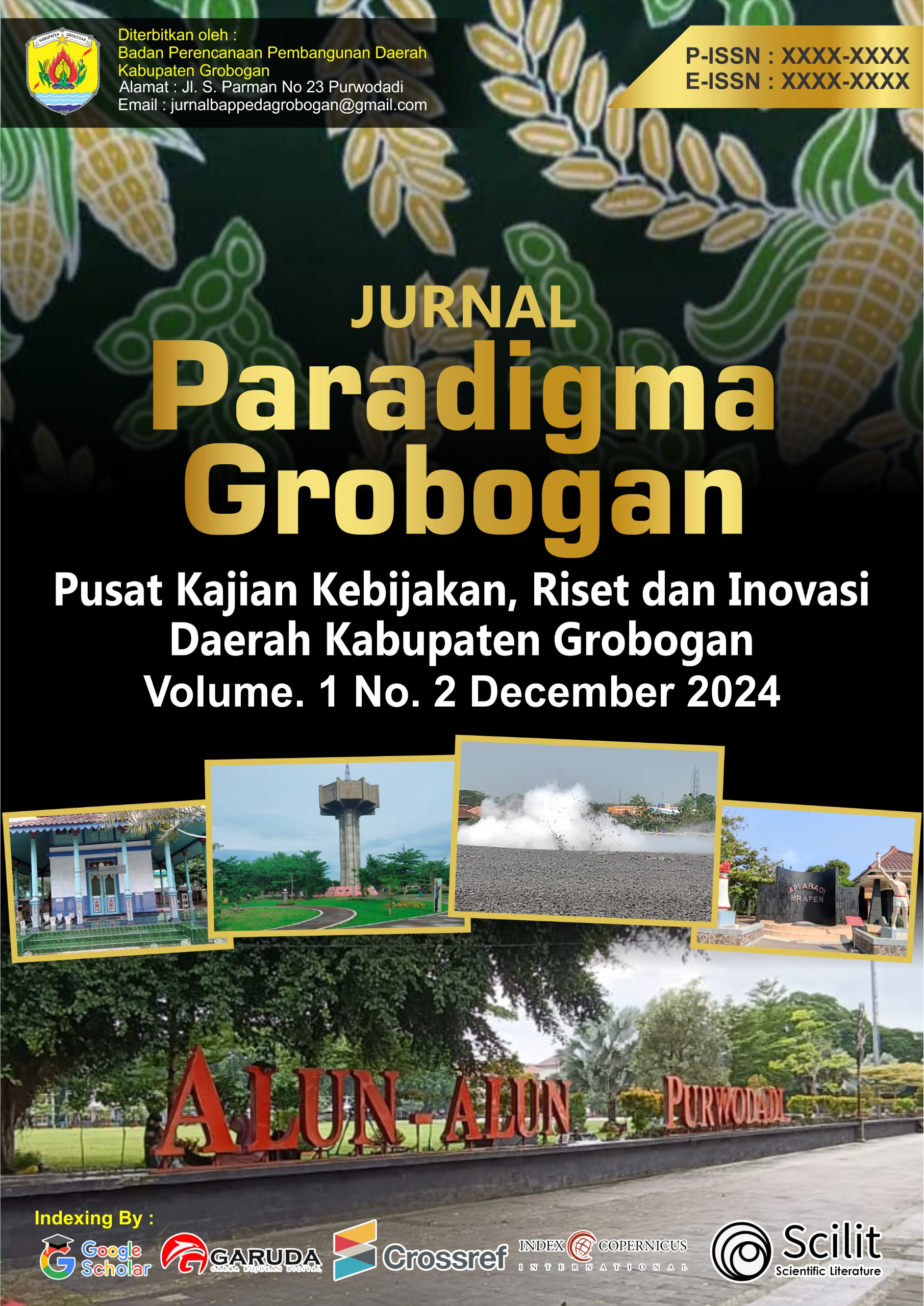Penyusunan Kajian Master Plan Peningkatan Pemanfaatan Kawasan Hutan Untuk Kesejahteraan Masyarakat
DOI:
https://doi.org/10.58684/paradigma.v1i2.5Keywords:
Characteristics, Area, Forest, SustainabilityAbstract
The area of ​​Grobogan Regency is almost 30% of the district area in the form of Production Forest Area, which is 70,159.73 Ha of the total area of ​​Grobogan Regency of 202,384.92 Ha, and there is at least agricultural land in the Forest Area of ​​8,664.86 Ha. The forest area in Grobogan Regency, which is quite large, should be managed based on the principle of sustainable forest management (SFM) which includes aspects of production, ecology and social sustainability. Thus, forest management will be able to provide a significant contribution to improving the welfare of the community, especially those around the forest area, without ignoring its economic and ecological functions. Fulfillment of the social aspect of sustainable forest management is a necessity because it will encourage the sustainability of production and ecology. The practical manifestation of fulfilling this social aspect is basically the involvement of the community, especially those around the forest, and other parties in the management or utilization of forests in a just manner. This has actually been realized by the central government, and a series of policies have been issued, especially those related to Social Forestry. The central government has allocated around 12.7 million hectares of areas to be managed and utilized by communities, through the People's Forest, Village Forest, Community Forest, and environmental services approaches as well as Customary Forests
References
Ahmadjayadi, C. (2001). Produk unggulan daerah. Jakarta: Kementerian Koperasi & UKM.
Anonim. (2000). Definisi produk unggulan. Jakarta: Biro Pusat Statistik.
Asmara, R. (2004). Pengembangan produk unggulan dalam perekonomian daerah. Bandung: Universitas Padjadjaran.
Brown, K., Turner, R. K., Hameed, H., & Bateman, I. (1987). Sustainable development: Economics and environment in the Third World. London: Earthscan.
Cao, K., Batty, M., Huang, B., Liu, Y., & Yu, L. (2011). Spatial multi-objective land use optimization: Extensions to the non-dominated sorting genetic algorithm-II. International Journal of Geographical Information Science, 25(12), 1949–1969.
Cooper, C. (1995). Tourism principle and practice. Harlow: Longman Group Limited.
Davis, M. A., & Masten, S. E. (2001). The economic institutions of capitalism. New York: Simon and Schuster.
Daryanto, A., & Yundy, N. (2010). Kriteria produk unggulan daerah. Bogor: IPB Press.
Ferguson, T. (1996). Sustainable forestry: A Canadian perspective. Vancouver: UBC Press.
Hickey, G. M. (2008). Evaluating sustainable forest management. Forest Policy and Economics, 10(4), 387–395.
Holvoet, B., & Muys, B. (2004). Sustainable forest management worldwide: A comparative assessment. Forest Policy and Economics, 6(1), 59-76.
Huseini, M. (1999). Model Saka-Sakti dalam pembangunan daerah. Depok: Universitas Indonesia.
IzakoviÄová, Z., Oszlányi, J., & Miklós, L. (2018). Sustainable land use in mountain regions. Springer.
Karsudi, dkk. (2010). Analisis daerah operasi objek dan daya tarik wisata alam. Jakarta: Direktorat Jenderal PHKA.
Lindenmayer, D. B., & Franklin, J. F. (2003). Towards forest sustainability. Island Press.
Maser, C. (1994). Sustainable forestry: Philosophy, science, and economics. Delray Beach, FL: St. Lucie Press.
Pendit, N. S. (1994). Ilmu pariwisata sebuah pengantar perdana. Jakarta: PT Pradnya Paramita.
Purnomo, H., Mendoza, G. A., Prabhu, R., & Yasmi, Y. (2005). Developing multi-stakeholder forest management scenarios: A multi-agent system simulation approach applied in Indonesia. Forest Policy and Economics, 7(4), 501-519.
Ricardo, D. (1917). Teori keunggulan komparatif dalam perdagangan. Cambridge: Cambridge University Press.
Steen, H. K. (1984). Sustained yield forestry in the United States. Duke University Press.
Tarigan, R. (2006). Ekonomi regional teori dan aplikasi. Jakarta: Bumi Aksara.
Undang-Undang No. 10 Tahun 2009 tentang Kepariwisataan. Jakarta: Kementerian Pariwisata dan Ekonomi Kreatif.
Undang-Undang No. 23 Tahun 2014 tentang Pemerintahan Daerah. Jakarta: Kementerian Dalam Negeri.
Undang-Undang No. 25 Tahun 2004 tentang Sistem Perencanaan Pembangunan Nasional. Jakarta: Kementerian Perencanaan Pembangunan Nasional/Bappenas.
Yoeti, O. A. (2008). Perencanaan dan pengembangan pariwisata. Jakarta: PT Pradnya Paramita.





